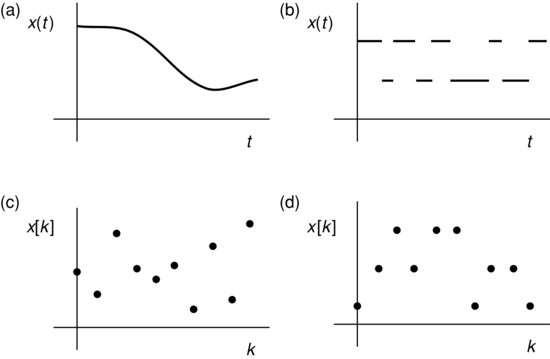6.4 TYPES OF RANDOM PROCESSES
Next, the four basic types of random processes are summarized, depending on whether ![]() and the random variables are continuous or discrete. For clarity and when necessary, we distinguish between a continuous-time process and a discrete-time sequence using the following notation:
and the random variables are continuous or discrete. For clarity and when necessary, we distinguish between a continuous-time process and a discrete-time sequence using the following notation:
FIGURE 6.6 Example realizations of random processes. (a) Continuous time, continuous amplitude. (b) Continuous time, discrete amplitude (two values). (c) Discrete time, continuous amplitude. (d) Discrete time, discrete amplitude (three values).

(6.17) ![]()
(6.18) ![]()
where brackets denote a sequence (time series), which is typically done for discrete-time signals (deterministic or random). Simple examples for each of the four types of realizations are shown in Figure 6.6 where in the discrete-time cases, the time instants are assumed to be uniformly spaced (which is also implied by using ![]() above).
above).
In addition to the four cases in the figure, it is possible that the underlying probability ...
Get Probability, Random Variables, and Random Processes: Theory and Signal Processing Applications now with the O’Reilly learning platform.
O’Reilly members experience books, live events, courses curated by job role, and more from O’Reilly and nearly 200 top publishers.

